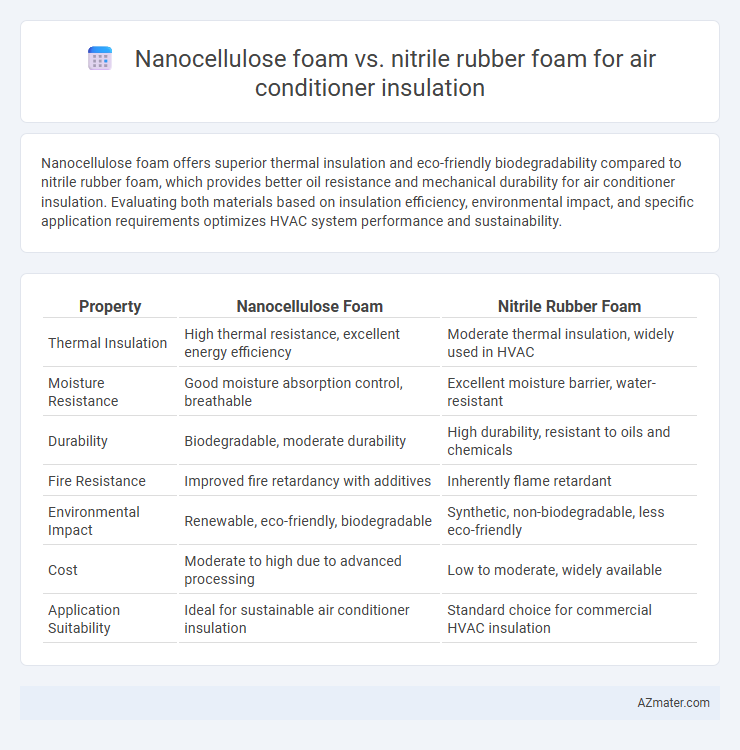Nanocellulose foam offers superior thermal insulation and eco-friendly biodegradability compared to nitrile rubber foam, which provides better oil resistance and mechanical durability for air conditioner insulation. Evaluating both materials based on insulation efficiency, environmental impact, and specific application requirements optimizes HVAC system performance and sustainability.
Table of Comparison
| Property | Nanocellulose Foam | Nitrile Rubber Foam |
|---|---|---|
| Thermal Insulation | High thermal resistance, excellent energy efficiency | Moderate thermal insulation, widely used in HVAC |
| Moisture Resistance | Good moisture absorption control, breathable | Excellent moisture barrier, water-resistant |
| Durability | Biodegradable, moderate durability | High durability, resistant to oils and chemicals |
| Fire Resistance | Improved fire retardancy with additives | Inherently flame retardant |
| Environmental Impact | Renewable, eco-friendly, biodegradable | Synthetic, non-biodegradable, less eco-friendly |
| Cost | Moderate to high due to advanced processing | Low to moderate, widely available |
| Application Suitability | Ideal for sustainable air conditioner insulation | Standard choice for commercial HVAC insulation |
Introduction to Air Conditioner Insulation Materials
Nanocellulose foam offers superior thermal insulation and high porosity compared to nitrile rubber foam, enhancing energy efficiency in air conditioners. Nitrile rubber foam provides excellent moisture resistance and flexibility, making it suitable for dynamic environments with potential vibrations. Both materials contribute to noise reduction and temperature regulation, but nanocellulose aligns better with sustainable and eco-friendly HVAC applications.
What is Nanocellulose Foam?
Nanocellulose foam is a lightweight, biodegradable material derived from cellulose fibers that offers superior thermal insulation and high porosity, making it an eco-friendly alternative for air conditioner insulation. Unlike nitrile rubber foam, which is synthetic and petroleum-based, nanocellulose foam provides excellent moisture resistance and mechanical strength with lower environmental impact. Its nanoscale structure enhances thermal insulation efficiency, reducing energy consumption in HVAC systems.
Overview of Nitrile Rubber Foam
Nitrile rubber foam is a synthetic elastomer known for its excellent resistance to oil, fuel, and chemicals, making it highly suitable for air conditioner insulation. It offers superior thermal insulation properties, durability, and flexibility compared to other materials, which helps in reducing energy loss and preventing condensation. Its closed-cell structure enhances moisture resistance, ensuring long-lasting performance in HVAC systems.
Thermal Insulation Performance: Nanocellulose vs Nitrile Rubber
Nanocellulose foam exhibits superior thermal insulation performance compared to nitrile rubber foam due to its highly porous structure and low thermal conductivity, typically around 0.030-0.040 W/m*K, enhancing energy efficiency in air conditioner systems. Nitrile rubber foam generally has a higher thermal conductivity value of approximately 0.040-0.050 W/m*K, resulting in comparatively less effective insulation. The improved thermal resistance of nanocellulose foam makes it a promising eco-friendly alternative for reducing heat transfer and improving the overall thermal management in HVAC applications.
Moisture Resistance and Water Absorption Capabilities
Nanocellulose foam exhibits superior moisture resistance and significantly lower water absorption compared to nitrile rubber foam, making it highly effective for air conditioner insulation in humid environments. Its hydrophobic surface properties and nanofiber network hinder water retention, enhancing thermal insulation longevity. Conversely, nitrile rubber foam absorbs more moisture, which can degrade its insulation performance and reduce durability over time.
Environmental Impact and Sustainability
Nanocellulose foam offers superior environmental sustainability compared to nitrile rubber foam due to its renewable biomass origin and biodegradability, significantly reducing landfill waste and toxic emissions during disposal. Nitrile rubber foam, derived from synthetic petroleum-based materials, involves energy-intensive production and contributes to non-biodegradable pollution, impacting ecological systems adversely. Life cycle assessments demonstrate that nanocellulose foam's lower carbon footprint and compatibility with circular economy principles make it a more eco-friendly choice for air conditioner insulation.
Durability and Lifespan Comparison
Nanocellulose foam exhibits superior durability for air conditioner insulation due to its high tensile strength and excellent resistance to thermal degradation, maintaining structural integrity over extended periods. Nitrile rubber foam offers good flexibility and moderate durability but tends to degrade faster under prolonged exposure to heat and humidity, reducing its effective lifespan. Consequently, nanocellulose foam generally outperforms nitrile rubber foam in longevity and sustained insulation performance in HVAC applications.
Cost Analysis and Market Availability
Nanocellulose foam offers a cost-effective alternative to nitrile rubber foam for air conditioner insulation due to its renewable raw materials and scalable production processes, which can reduce manufacturing expenses. Nitrile rubber foam, while widely available in the market with established supply chains, typically incurs higher costs driven by petrochemical price volatility and complex processing requirements. Market availability favors nitrile rubber foam currently, but increasing investments in sustainable materials and advancements in nanocellulose foam production are rapidly improving its commercial accessibility.
Installation Process and Practical Considerations
Nanocellulose foam offers a lightweight and flexible installation process for air conditioner insulation, conforming easily to irregular surfaces and reducing labor time compared to nitrile rubber foam, which often requires precise cutting and fitting due to its denser structure. Nanocellulose's inherent moisture resistance minimizes the risk of mold growth in humid environments, whereas nitrile rubber foam provides superior resistance to oils and chemicals, making it suitable for industrial settings. Practical considerations include nanocellulose foam's biodegradability and sustainability credentials versus the longer-lasting durability and established thermal performance of nitrile rubber foam in HVAC applications.
Future Trends in Air Conditioner Insulation Materials
Nanocellulose foam exhibits superior thermal insulation and eco-friendly biodegradability compared to nitrile rubber foam, positioning it as a promising material in future air conditioner insulation applications. Advances in nanotechnology and sustainable manufacturing processes enhance nanocellulose's mechanical strength and moisture resistance, critical for HVAC system durability. Growing regulatory emphasis on green building standards and reduced carbon footprints accelerates the adoption of plant-based nanocellulose foam over synthetic nitrile rubber alternatives.

Infographic: Nanocellulose foam vs Nitrile rubber foam for Air conditioner insulation
 azmater.com
azmater.com